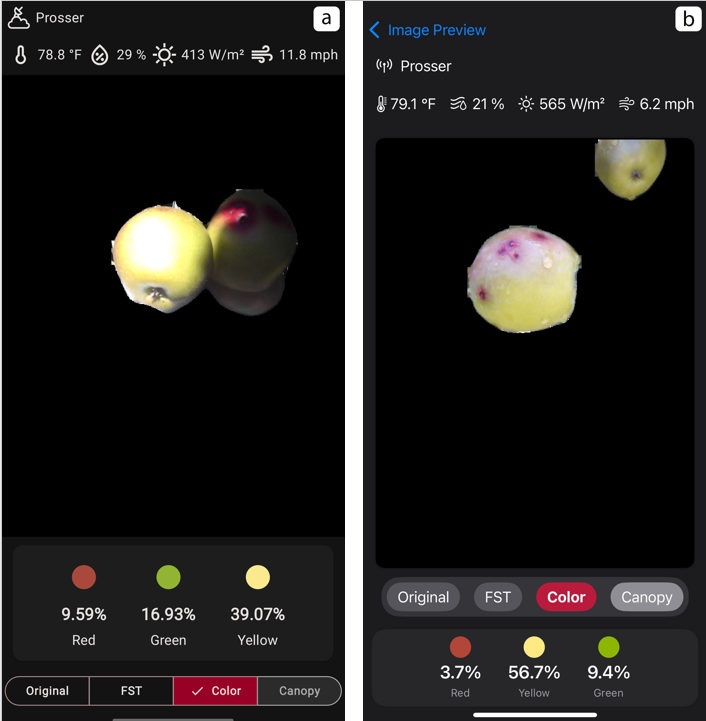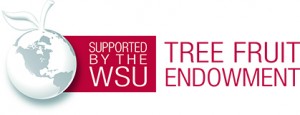Written by Nipun Thennakoon, Lav Khot, Washington State University, June 04, 2025
Introduction
Sunburn is a major concern in apple production, especially in Washington State, where it can lead to yield losses of over 10% annually and up to 40% under severe conditions (Racsko & Schrader, 2012) (Bolivar-Medina & Kalcsits, 2022) . It remains the leading cause of apple cullage and reduced packouts in the region (Schmidt, 2018).
Fruit surface temperature (FST) is a reliable indicator of sunburn susceptibility (Wang, Ranjan, Khot, & Peters, 2020), but traditional methods of measuring FST—such as thermocouples or bulb thermometers—are invasive and unsuitable for commercial use (Li, Peters, Zhang, & Zhang, 2014). Thermal infrared (IR) imaging provides a non-destructive alternative and integrating IR cameras with (iOS® or Android®) smartphones offers a handy solution for real-time in-field FST monitoring within orchard blocks.
Beyond FST, apple fruit color is a critical quality attribute influencing harvest timing, marketability, and consumer acceptance. Monitoring both FST and fruit color using smartphone applications can help growers make informed management decisions throughout the growing season.
AWN CropAI
AWN CropAI is a smartphone application platform designed by AgWeatherNet to support growers in managing crop stressors through a suite of innovative applications. To support growers in managing sunburn risk and fruit quality, we have developed a smartphone-based application within AWN CropAI platform, that combines radiometric thermal imaging technology with artificial intelligence for real-time fruit sunburn risk assessment. Besides FST, applications also quantify fruit color (i.e., %red, %green, %yellow) in real time. Designed for on-site decision-making, this application provides an easy-to-use interface with multiple integrated features as detailed below. AWN CropAI is available for free on both Android® and iOS® platforms. Growers, researchers, and industry professionals can download the app using the links below:
- Apple App Store: https://apps.apple.com/us/app/awn-cropai/id6744830192?uo=2
- Google Play Store: https://play.google.com/store/apps/details?id=edu.wsu.weather.fst&hl=en_US
Weather guided Fruit Surface Temperature Forecasting
AWN CropAI provides accurate, weather-guided hourly forecasts (Figure 1) of FST based on the user’s current location or a custom location. This feature uses neaby AgWeatherNet station and associated forecats to help growers anticipate heat stress events in advance and optimize the timing of mitigation strategies such as irrigation, shade deployment, or evaporative cooling.

Thermal-RGB Imagery driven Fruit Surface Temperature Estimation
The application seamlessly connects with supported thermal-RGB cameras (e.g., FLIR ONE® Pro (USB) and FLIR ONE® Edge Pro (Wireless), (Figure 2), allowing users to capture thermal-RGB images of fruits within the field of view directly within the application (Figure 3). The segmentation algorithms run in the background then automatically detect fruits in the captured image and calculate the average FST using the hottest 20% of pixels to provide the sunburn risk level (Figure 4).



Fruit Color Analysis
The application also performs HSV (Hue, Saturation, Value) color analysis of the captured images to quantify the proportions of red, green, and yellow colors in the detected fruits (Figure 5). This information can help growers in assessing fruit maturity, optimize harvest timing, and ensure the fruit meets market quality standards.

Application Knowledge Center
The application also includes an in-app knowledge center (Figure 6) designed for a quick glance of key concepts related to fruit surface temperature, sunburn risk, and fruit color analysis. It provides practical guidance and background information to support effective use of the application in the field.

The FUTURE
We are actively working to expand the capabilities of AWN CropAI to support a wider range of crops and applications. In the immediate future, we will be adding features to use the application for estimating i) grape berry surface temperature, and ii) apple/grape canopy stress.
In addition to its practical features, AWN CropAI supports research by enabling growers/users to contribute to the improvement of weather-guided fruit surface temperature forecasting models through crowdsourcing. Currently, the application’s weather guided FST forecast is calibrated specifically for the Honeycrisp apple cultivar. To expand forecasting support to other cultivars, the application allows users to share anonymized thermal-RGB images and related metadata. Data sharing is entirely optional—users may opt in and opt out at any time via the app’s settings. This ground truth imagery data is essential for refining and validating cultivar/region specific (or independent) models. For example, these models will be trained using nearby weather station data (along with forecasts) as inputs with application collected thermal-RGB imagery as ground truth. We plan to work with AI modelers, involved in WSU-led AgAID Institute to realize these efforts in the near future. If you are interested in beta testing and helping with model improvement efforts, please write us at weather@wsu.edu.
Funding and acknowledgements
This application is a byproduct of the research conducted in WSU PrecisionAg Laboratory with support from NSF/USDA NIFA Cyber–Physical Systems (Award No: 2021–67021–34336, project #0745) and Washington Tree Fruit Research Commission. It will be further improved with support from NSF/USDA NIFA funded and WSU led AgAID Institute. Dheeraj Vurukuti contributed towards application development and refinement. Dr. Basavaraj Amogi developed the weather guided FST estimation algorithm and contributed to the conceptualization and refinement as this work is in part progression of his PhD Dissertation (Amogi, 2023).
References
Amogi, B. (2023). Edge-intelligence enabled infield sensing system for heat stress mitigation in apple orchards. Washington State University.
Bolivar-Medina, J., & Kalcsits, L. (2022, July). Sunburn in apple and strategies to mitigate it. Retrieved from WSU Tree Fruit: https://treefruit.wsu.edu/sunburn-in-apple-and-strategies-to-mitigate-it/
Li, L., Peters, T., Zhang, Q., & Zhang, J. (10 de 2014). Modeling apple surface temperature dynamics based on weather data. Sensors (Switzerland), 14(11), 20217-20234.
Racsko, J., & Schrader, L. (11 de 2012). Sunburn of Apple Fruit: Historical Background, Recent Advances and Future Perspectives. Critical Reviews in Plant Sciences, 31(6), 455-504.
Schmidt, T. (2018, June 22). Apple Sunburn 101. Retrieved from WSU Tree Fruit: https://treefruit.wsu.edu/article/apple-sunburn-101/
Wang, B., Ranjan, R., Khot, L., & Peters, R. (2 de 2020). Smartphone application‐enabled apple fruit surface temperature monitoring tool for in‐field and real‐time sunburn susceptibility prediction. Sensors (Switzerland), 20(3).
Fruit Matters articles may only be republished with prior author permission © Washington State University. Reprint articles with permission must include: Originally published by Washington State Tree Fruit Extension Fruit Matters at treefruit.wsu.edu and a link to the original article.
